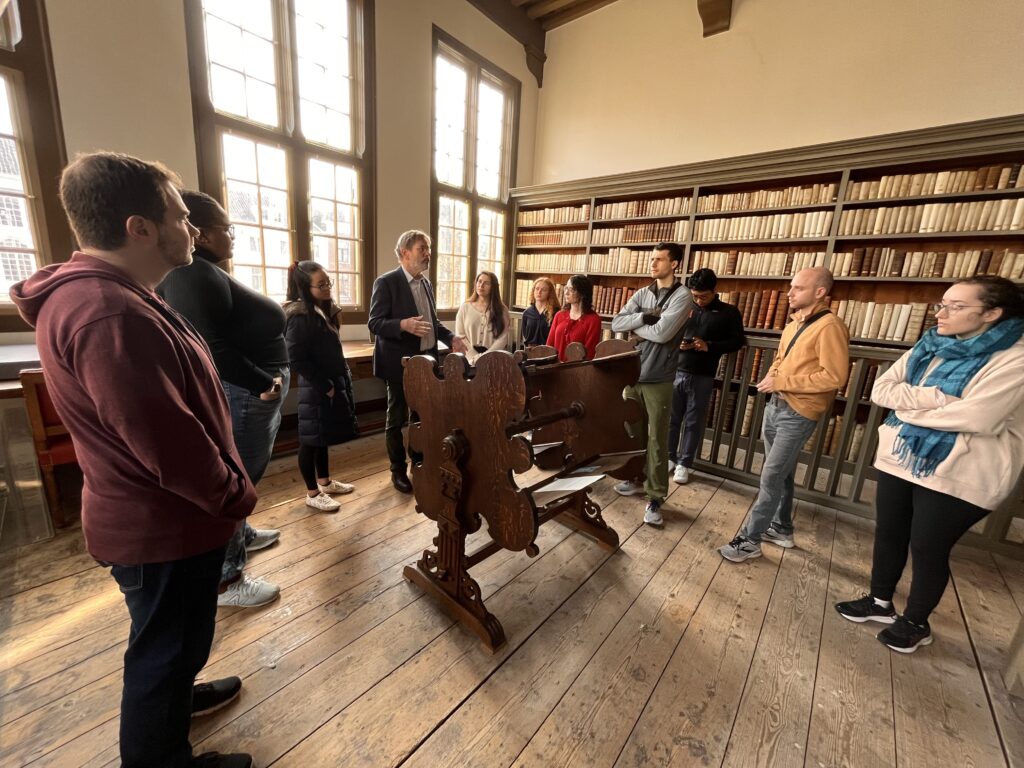Last month, the Center for the History of Medicine at Becker Library once again sponsored a spring break trip to Europe for Phase I medical students. While last year’s trip went to northern Italy to explore the origins of dissection in European medicine, this year focused on the medical legacy of the Dutch Golden Age by visiting key sites in the cities of Leiden and Amsterdam.
The Italian universities of Bologna and Padua were arguably the most significant sites of medical research in the 16th century, but the 17th century saw the emergence of northern Europe as a hotbed of study. One of the most popular places for young men to pursue their medical degree was the University of Leiden, founded in 1575 and the oldest university in the Netherlands. Many of the most well-loved atlases in Becker’s rare book collections are the works of former Leiden professors and students, including those of Bernard Albinus and Govard Bidloo, which make regular appearances at our annual display of rare anatomical texts.
Leiden’s legacy as a center of medicine can still be seen today. During their time there, students visited the Hortus Botanicus—the Netherlands’s oldest botanical garden, originally founded as a medicinal herb garden for the medical faculty—and the Rijiksmuseum Boerhaave, one of Europe’s finest scientific museums and home to both an outstanding collection of historic medical artifacts and a reproduction of the original Leiden anatomical theatre. They also paid a visit to the Bibliotheca Thysiana, a 17th century library still housed in its original environment. While the Thysiana’s founder, Johannes Thysius, was a lawyer by trade, his collection includes books from a wide variety of disciplines including botany and medicine, showing how early modern intellectualism was not as sharply divided between the humanities and the sciences as it is today. Instead, physicians were expected to be knowledgeable in all of the liberal arts, including philosophy and astronomy.
Both the University of Leiden and the University of Amsterdam maintain anatomical collections whose origins reach back to the 18th century. Visiting these was not only a remarkable opportunity to see specimens originally prepared by famous anatomists such as Frederick Ruysch and Siegfried Albinus; it also provided a window into medical ethics. The vast majority of the anatomical and pathological specimens on display were taken before there was any real consideration of patient consent, and some of them were also acquired through colonial rule. Their presence in museums raises numerous questions—should they be displayed at all? If so, how should they be contextualized? Should medical museums be open to the public at all, or limited to visits by medical professionals? As one student put, “After hearing from the guides at the medical schools in the Netherlands, it is clear that other societies are also grappling with questions about the history of their medical institutions. It was valuable to hear how this type of complex and sensitive question about medicine’s history is being broached outside of the U.S.”
And, of course, the importance of art should not be forgotten. Early modern anatomical texts are known for being extremely artistic in comparison to their modern counterparts, and the Dutch atlases are no exception. Our visit would not be complete without a visit to the Mauritshuis Art Museum to take in the masterpieces of the Dutch Golden Age. While the museum’s most famous piece is probably Vermeer’s Girl With a Pearl Earring, we of course had to visit Rembrandt’s The Anatomy Lesson of Dr. Nicolaes Tulp, one of the world’s most famous depictions of dissection in the early modern period.
We are deeply grateful to the generosity of Dr. Bernard Becker for the gift that made this trip possible. We are also hopeful that we will be able to incorporate this trip into an elective for Phase 3 medical students, thereby giving more students the opportunity to interact with medicine’s rich past.




